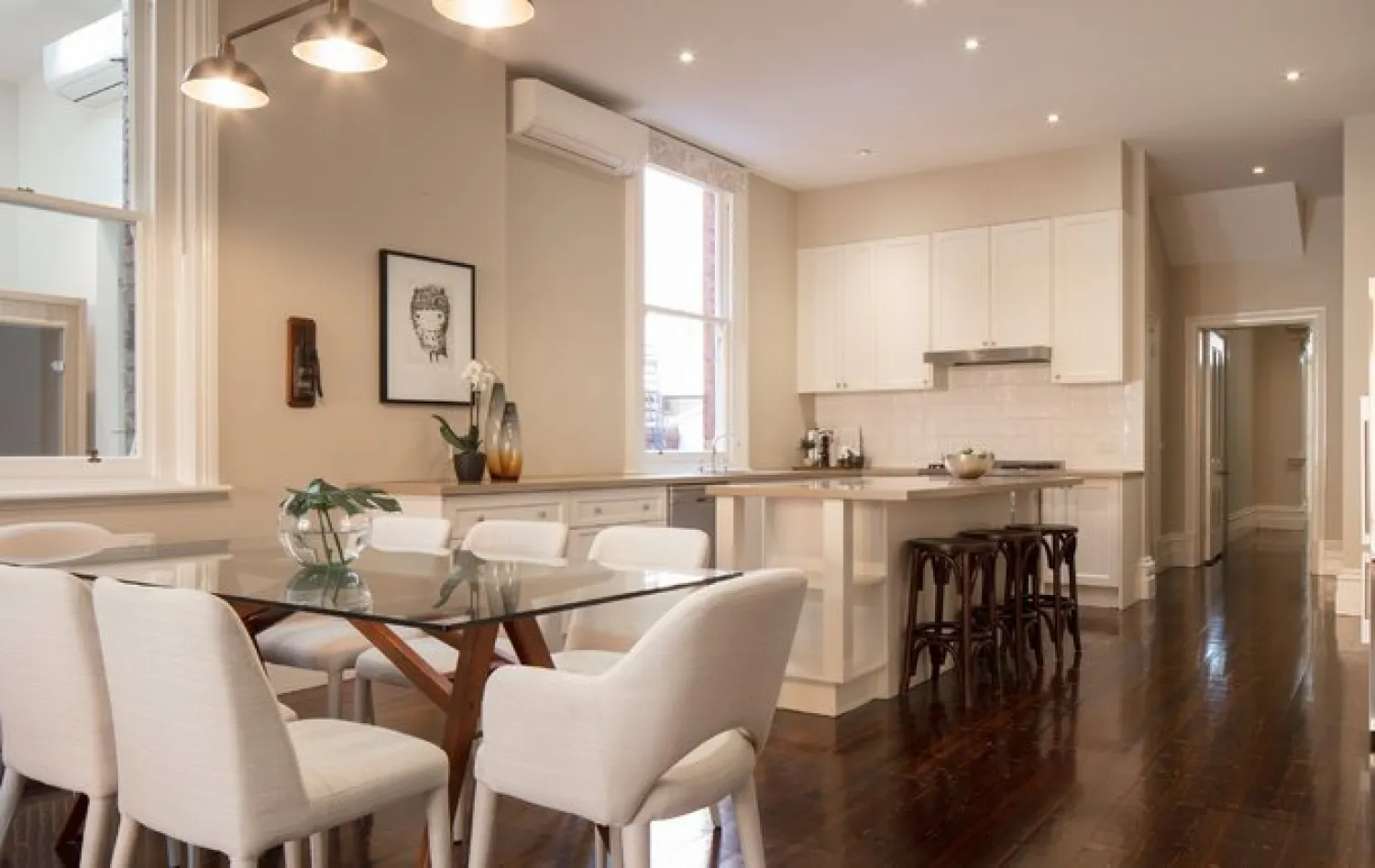This two-story Victorian house in Melbourne, Australia, with a facade of cream-colored gingerbread trim, was renovated in the past year to add modern features. Known as Exeter and built around 1888, the five-bedroom, five-bathroom house, which sits on a 4,306-square-foot lot, was extended at the rear to add a heated outdoor dining area and a garage with a second-floor studio apartment. The home itself has 4,424 square feet of living space.
While terraced Victorian houses, which share walls with neighboring buildings, are fairly common in Melbourne, sizable free-standing Victorian homes like Exeter are more of a rarity, said Michael Armstrong, a partner at the brokerage Kay & Burton, which has the listing.
The house’s main entrance is off a veranda and opens into a reception hall with a staircase and powder room; a living room and study are to the right. Victorian details include lofty ceilings, original skirting boards, cornices and ceiling rosettes. The living room has imported French-silk drapes, and the study has a built-in handcrafted French cabinet with desk. Both rooms have working fireplaces.
Beyond the staircase is a modern open-plan kitchen and dining area adjacent to a large multipurpose room with skylights, a powder room and a sauna. The kitchen has an Italian gas oven and stone countertops.
There are five bedrooms on the second floor, including the master, which has a balcony, a walk-in closet and an en-suite bathroom with a free-standing tub and Italian limestone tilework. A small adjacent bedroom could be used as a nursery. A third bedroom has an en-suite bath, while the two remaining bedrooms share a bathroom.
The first-floor dining area has bifold doors opening to a covered alfresco dining area with a barbecue, a working fireplace, landscaping and heaters. Beyond is a two-car garage with a wine cellar and second-floor studio apartment, along with a covered car space. The home has hydronic heating and cooling, as well as seven perimeter security cameras.
Exeter is in East Melbourne, one of the city’s oldest suburbs, just east of the central business district. The area has some of Melbourne’s most notable landmarks, including Parliament House, the Old Treasury Building and St. Patrick’s Cathedral. The home is steps from Fitzroy Gardens, as well as the Melbourne Cricket Ground in Yarra Park. The restaurants, shops and theaters in the business district are about four minutes away by tram. Melbourne’s international airport is about a 45-minute drive.
MARKET OVERVIEW
Greater Melbourne, which has about 4.49 million residents, has seen a surge in home prices over the past few years, largely due to rapid population growth, Mr. Armstrong said. While apartments are plentiful, houses are in high demand.
“We have a noticeable undersupply of good, quality housing,” he said. “Anything with any quality to it sees a lot of competition, particularly in the inner eastern suburbs.”
Melbourne’s home prices jumped 15.1 percent year-over-year in June 2017, to a median price of 865,712 Australian dollars, or about $683,912, according to the property marketing group Domain. The median apartment price was 474,848 Australian dollars, or about $375,130.
Other factors affecting the housing market in Melbourne, which is the capital of Victoria state, are low interest rates, low unemployment and a strengthening economy, said Tim Derham, a director, agent and auctioneer with Abercromby’s Real Estate.
In Toorak, an upscale neighborhood that is often a first stop for foreign home buyers, the median house price is 4,725,000 Australian dollars, or about $3.73 million, Mr. Derham said. Other suburbs popular with foreign buyers include Box Hill and Mount Waverley, he said.
While home prices have grown in a robust way since about 2010, that type of growth may be unrealistic for the future, and price growth will likely level off, Mr. Armstrong said.
WHO BUYS IN MELBOURNE
Melbourne gets many foreign buyers, particularly for homes over 5 million Australian dollars, or about $3.95 million, brokers said.
Buyers from mainland China have been the largest group by far in recent years, Mr. Armstrong said, but the tide has stemmed a bit as the Chinese government has put limits on capital outflows. Besides the Chinese, those from countries like Singapore and Malaysia also buy homes in large numbers, he said. Buyers from Europe and North America are less common.
BUYING BASICS
Foreigners generally must have either residency status or a visa to buy property in Australia, and they must apply to the Federal Investment Review Board to obtain approval. The process takes about 30 days, and the fee is dependent on the type of property and the price, Mr. Armstrong said.
Most buyers hire a lawyer to handle the transaction; the fee is usually between 2,000 and 5,000 Australian dollars, or $1,580 to $3,950, Mr. Derham said.
Buyers in the state of Victoria must pay a 5.5 percent stamp duty, and foreign buyers pay an additional federal tax of 7 percent. Australian banks offer mortgages to foreign buyers on a case-by-case basis, Mr. Armstrong said.
LANGUAGES AND CURRENCY
English; Australian dollar (1 Australian dollar = $0.79)
TAXES AND FEES
Annual taxes, or council rates, are about 6,979 Australian dollars, or $5,500, on this property.
The New York Times









